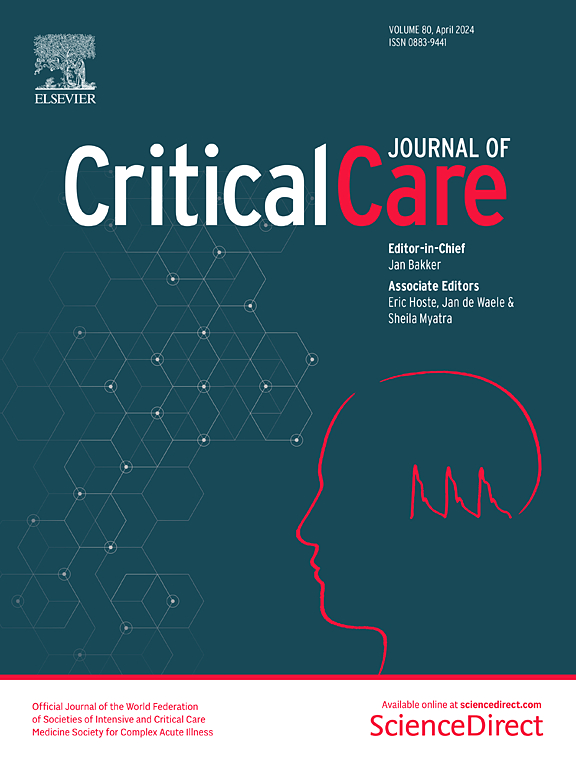Clinical features and treatments of VEXAS syndrome in critical care: a scoping review
IF 8.8
1区 医学
Q1 CRITICAL CARE MEDICINE
引用次数: 0
Abstract
Vacuoles, E1 enzyme, X-linked, autoinflammatory, somatic (VEXAS) syndrome is a recently discovered severe disorder that predominantly affects adult males, characterized by systemic inflammation and hematologic abnormalities. Despite its profound impact on patient outcomes, awareness of VEXAS syndrome among critical care providers remains severely limited, often leading to delayed recognition, diagnosis, and initiation of appropriate treatment. This study aims to address this knowledge gap by conducting a scoping review on VEXAS syndrome in the critical care setting. This scoping review followed the PRISMA-ScR guidelines and Joanna Briggs Institute methodology, analyzing data from Cochrane CENTRAL, MEDLINE via PubMed, EMBASE, and Web of Science on May 19, 2024. We included studies that reported clinical features and treatments of patients with VEXAS syndrome requiring critical care. Of the 1262 reports identified, 78 reports met the inclusion criteria, including 45 case reports/series, 17 observational studies, 15 reviews, and one systematic review. Analysis of 55 cases revealed a median age of 69 with a strong male predominance (54/55). ICU admission rates ranged from 28 to 33%, with mortality rates between 18 and 40%. Critical manifestations included shock, hemophagocytic lymphohistiocytosis, acute respiratory distress syndrome, thrombosis, and airway edema. Sepsis was the leading cause of death, followed by other causes including VEXAS syndrome related organ failure, cardiovascular events, and intestinal perforation. Treatment approaches combined conventional critical care measures with immunosuppressive and immunomodulatory therapies, although infectious complications were frequently reported. This review revealed the lack of systematically analyzed studies focusing on VEXAS syndrome in the critical care setting, suggesting a significant gap in understanding the clinical characteristics and optimal treatments for VEXAS syndrome. Further research focused on VEXAS syndrome in the critical care setting is essential to improve early recognition, develop standardized treatment protocols, and ultimately improve patient outcomes in this complex patient population.重症监护中 VEXAS 综合征的临床特征和治疗方法:范围界定综述
空泡,E1酶,x -连锁,自体炎症,躯体(VEXAS)综合征是最近发现的一种主要影响成年男性的严重疾病,其特征是全身炎症和血液系统异常。尽管它对患者预后有深远的影响,但重症监护提供者对VEXAS综合征的认识仍然严重有限,常常导致延迟识别、诊断和适当治疗的开始。本研究旨在通过对重症监护环境中VEXAS综合征的范围审查来解决这一知识差距。该综述遵循PRISMA-ScR指南和Joanna Briggs研究所的方法,分析了2024年5月19日来自Cochrane CENTRAL、MEDLINE、PubMed、EMBASE和Web of Science的数据。我们纳入了报道了需要重症监护的VEXAS综合征患者的临床特征和治疗方法的研究。在确定的1262份报告中,78份报告符合纳入标准,包括45份病例报告/系列、17项观察性研究、15项综述和1项系统综述。55例患者中位年龄69岁,男性居多(54/55)。ICU住院率为28%至33%,死亡率为18%至40%。主要表现为休克、噬血细胞性淋巴组织细胞增多症、急性呼吸窘迫综合征、血栓形成和气道水肿。脓毒症是导致死亡的主要原因,其次是其他原因,包括与VEXAS综合征相关的器官衰竭、心血管事件和肠穿孔。治疗方法将常规重症监护措施与免疫抑制和免疫调节治疗相结合,尽管经常报道感染并发症。本综述显示,缺乏系统分析的研究侧重于重症环境中的VEXAS综合征,这表明在了解VEXAS综合征的临床特征和最佳治疗方法方面存在重大差距。在重症监护环境中进一步研究VEXAS综合征对于提高早期识别,制定标准化治疗方案,并最终改善这一复杂患者群体的患者预后至关重要。
本文章由计算机程序翻译,如有差异,请以英文原文为准。
求助全文
约1分钟内获得全文
求助全文
来源期刊

Critical Care
医学-危重病医学
CiteScore
20.60
自引率
3.30%
发文量
348
审稿时长
1.5 months
期刊介绍:
Critical Care is an esteemed international medical journal that undergoes a rigorous peer-review process to maintain its high quality standards. Its primary objective is to enhance the healthcare services offered to critically ill patients. To achieve this, the journal focuses on gathering, exchanging, disseminating, and endorsing evidence-based information that is highly relevant to intensivists. By doing so, Critical Care seeks to provide a thorough and inclusive examination of the intensive care field.
 求助内容:
求助内容: 应助结果提醒方式:
应助结果提醒方式:


